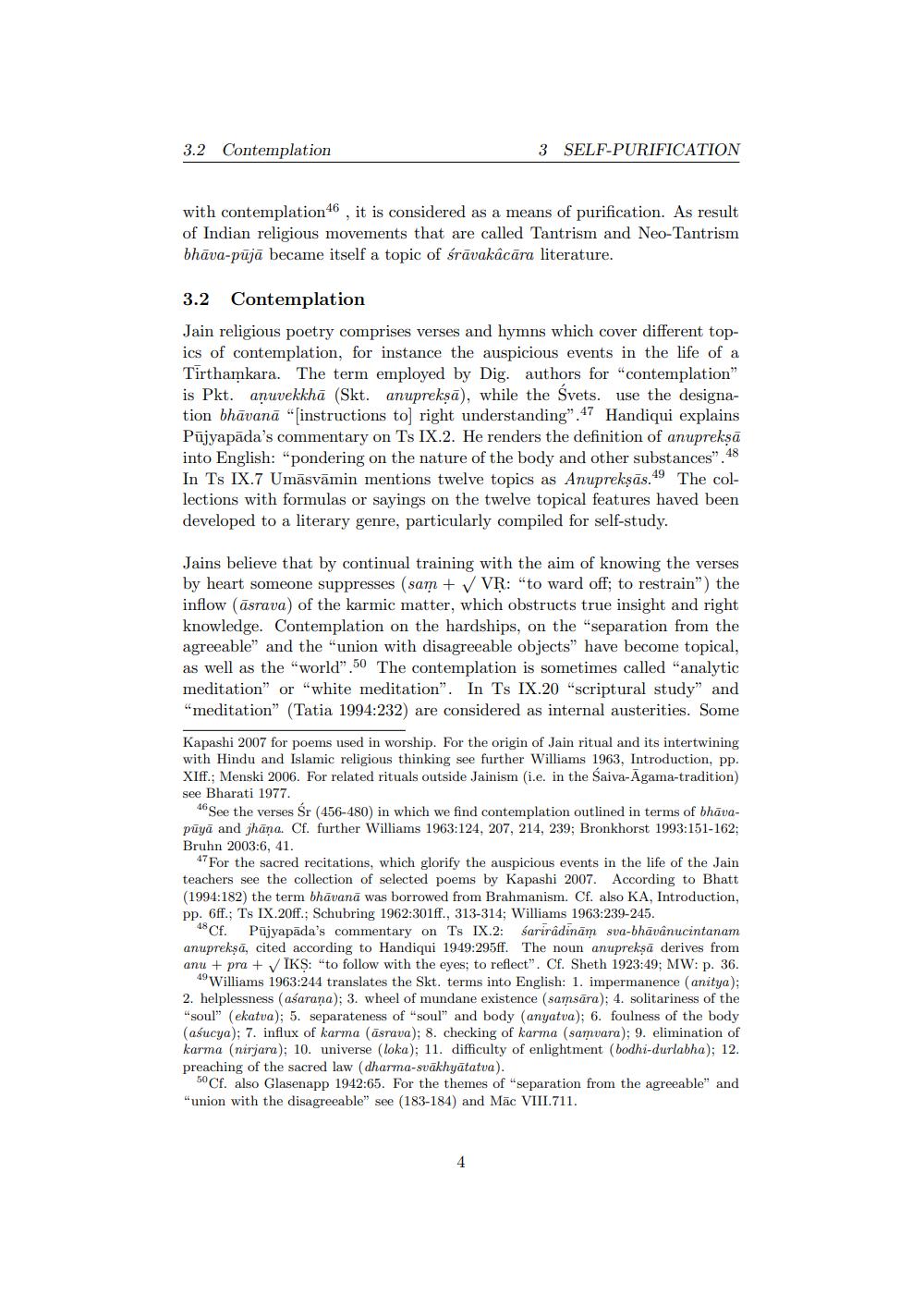________________
3.2 Contemplation
3 SELF-PURIFICATION
with contemplation46, it is considered as a means of purification. As result of Indian religious movements that are called Tantrism and Neo-Tantrism bhāva-pujā became itself a topic of śrāvakâcāra literature.
3.2 Contemplation Jain religious poetry comprises verses and hymns which cover different topics of contemplation, for instance the auspicious events in the life of a Tirthamkara. The term employed by Dig. authors for "contemplation" is Pkt. aṇuvekkhā (Skt. anupreksā), while the Svets. use the designation bhāvanā "instructions to right understanding" 47 Handiqui explains Pūjyapāda's commentary on Ts IX.2. He renders the definition of anupreksā into English: "pondering on the nature of the body and other substances". 48 In Ts IX.7 Umāsvāmin mentions twelve topics as Anuprekşās.49 The collections with formulas or sayings on the twelve topical features haved been developed to a literary genre, particularly compiled for self-study.
Jains believe that by continual training with the aim of knowing the verses by heart someone suppresses (sam + ✓ VR: "to ward off; to restrain") the inflow (āsrava) of the karmic matter, which obstructs true insight and right knowledge. Contemplation on the hardships, on the "separation from the agreeable" and the "union with disagreeable objects" have become topical, as well as the "world" 50 The contemplation is sometimes called "analytic meditation" or "white meditation". In Ts IX.20 "scriptural study" and "meditation" (Tatia 1994:232) are considered as internal austerities. Some
Kapashi 2007 for poems used in worship. For the origin of Jain ritual and its intertwining with Hindu and Islamic religious thinking see further Williams 1963, Introduction, pp. XIff.; Menski 2006. For related rituals outside Jainism i.e. in the Saiva-Agama-tradition) see Bharati 1977.
46 See the verses Śr (456-480) in which we find contemplation outlined in terms of bhāvapāyā and jhāna. Cf. further Williams 1963:124, 207, 214, 239; Bronkhorst 1993:151-162: Bruhn 2003:6, 41.
47 For the sacred recitations, which glorify the auspicious events in the life of the Jain teachers see the collection of selected poems by Kapashi 2007. According to Bhatt (1994:182) the term bhāvanā was borrowed from Brahmanism. Cf. also KA, Introduction, pp. 6ff.; Ts IX.20ff.; Schubring 1962:301ff., 313-314; Williams 1963:239-245.
48 Cf. Pūjyapāda's commentary on Ts IX.2: sariradinām sva-bhāvanucintanam anuprekşā, cited according to Handiqui 1949:295ff. The noun anupreksā derives from anu + pra + IKS: "to follow with the eyes; to reflect". Cf. Sheth 1923:49; MW: p. 36.
49 Williams 1963:244 translates the Skt. terms into English: 1. impermanence (anitya); 2. helplessness (asarana); 3. wheel of mundane existence (samsāra); 4. solitariness of the "soul" (ekatua); 5. separateness of soul" and body (anyatua); 6. foulness of the body (aśucya); 7. influx of karma (āsrava); 8. checking of karma (samvara); 9. elimination of karma (nirjara); 10. universe (loka); 11. difficulty of enlightment (bodhi-durlabha); 12. preaching of the sacred law (dharma-svākhyātatua)
50 Cf. also Glasenapp 1942:65. For the themes of "separation from the agreeable" and "union with the disagreeable" see (183-184) and Māc VIII.711.




